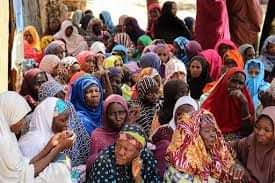By Adamu Abubakar

In the midst of conflict, natural disasters, and other humanitarian crises, women and children are among the most vulnerable populations, facing a myriad of challenges when forced to seek refuge in Internal Displaced Persons (IDP) camps. These individuals endure hardships that often exacerbate existing inequalities and put their safety, health, and well-being at risk.
Therefore, it is imperative to implement targeted solutions to address the specific needs of women and children in IDP camps, fostering a supportive environment that promotes empowerment and resilience.
Ensuring the safety and security of women and children is paramount. Establishing safe spaces within the camps, equipped with trained personnel to provide protection and support can offer a sanctuary from gender-based violence and exploitation. Enhanced security measures, such as increasing the presence of security personnel and implementing early warning systems are essential to prevent and respond to incidents of violence effectively.
Education plays a vital role in empowering women and children in IDP camps, offering a pathway to a brighter future. Investing in educational initiatives, such as temporary schools, vocational training programs, and girls’ education promotion can equip them with valuable skills and knowledge, enhancing their opportunities for personal development and economic independence.
Moreover, access to healthcare services is crucial for the well-being of women and children in IDP camps. Providing comprehensive healthcare, including maternal and reproductive health services can address their specific needs and reduce health risks. Mobile clinics expand health facilities and training for healthcare workers thereby ensuring that essential services are readily available.
Improving living conditions within the camps is essential to safeguard the health and dignity of women and children. Access to clean water, proper sanitation facilities and adequate shelter is fundamental to preventing diseases and promoting overall well-being. Hygiene promotion programs can further contribute to maintaining a healthy environment within the camps.
More so, supporting livelihood opportunities for women can enable economic empowerment and self-sufficiency. Training in income-generating activities, establishing women-led cooperatives, and facilitating access to microfinance initiatives can help women generate income and support their families, reducing vulnerabilities and promoting resilience.
Psychosocial support services are essential to address the emotional needs of women and children coping with the trauma of displacement. Counseling, support groups, and mental health services can provide a healing environment and promote resilience in the face of adversity.
Ensuring legal protection for women and children in IDP camps is critical to upholding their rights and seeking justice in cases of abuse or exploitation. Providing legal aid services, raising awareness about rights, and ensuring access to a fair and effective justice system can help protect vulnerable individuals and hold perpetrators accountable.
In to the above points, addressing the challenges faced by women and children in IDP camps requires a comprehensive and compassionate approach that prioritizes their safety, well-being, and empowerment. By implementing targeted remedies that address their specific needs and vulnerabilities, we can create a supportive environment that fosters resilience, dignity, and hope for a better future.
Collaborative efforts between government agencies, humanitarian organizations, and local communities are essential to effectively support women and children in IDP camps, ensuring that they receive the care and protection they deserve in times of crisis.
